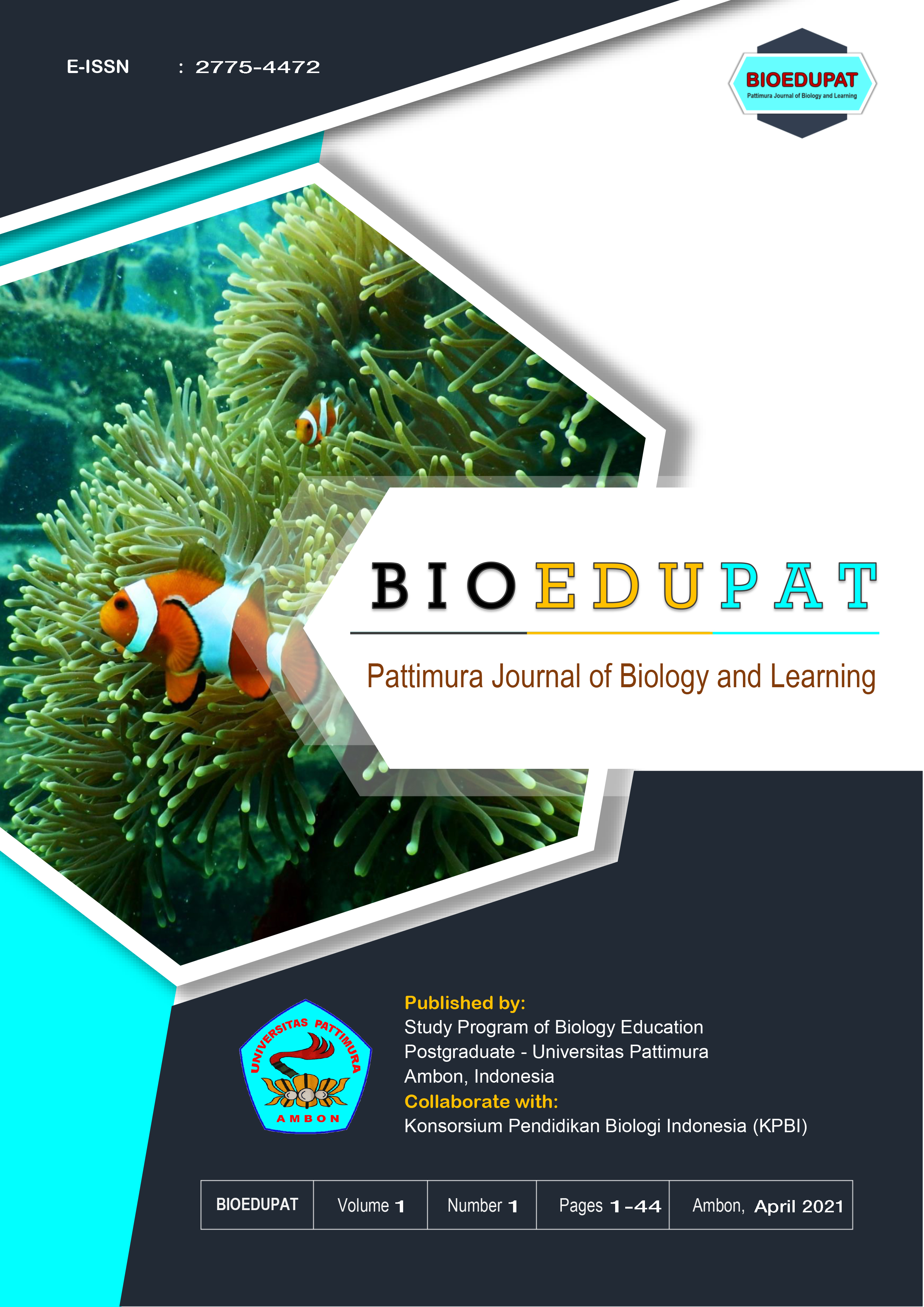People behavior and anopheles mosquitous bionomic and its correlation with malaria parasite prevalence and case fatality rate (CFR) in West Seram Regency
Abstract
WHO mentions that 300-500 million of people in the world are infected with malaria every year, 110 million of people perform the symptoms, and 2.7 million are even died. In 2005, malaria patients in West Seram Regency were 7.760 people. The research design was Survey and Case control in order to investigate the behavior of local society, Anopheles mosquito bionomic, malaria prevalence and case fatality rate (CFR). Purposive sampling was taken from the people of 2 villages in 3 districts with the highest numbers of patients. 30 people were taken from each village so total sample was 180 respondents. Anopheles bionomics involved habitat and breeding. Malaria cases in 2012-2016 obtained from public health center, health department office and public hospitals. Data analysis was done by using Pearson correlation test. The results showed that people behavior strongly agreed in overcoming the spread of Anopheles mosquitoes and malaria. Natural breeding habitat in swamps area where mangrove trees grow and sago trees at trenches, rice fields, ponds and water on the boat. Anopheles larvae species encountered was Anopheles sundaicus that actively bite all night inside and outside the house with peak activity at 02.00-03.00 a.m. Average larval density was 5.00, 9.00 and Average density of Anopheles mosquitoes was 5.09 - 9.85. The Prevalence Rate of Malaria is still high and Case Fatality Rate (CFR) is low. There is a significant correlation between people behavior and prevalence rate and no correlation with Case Fatality Rate (CFR)
Downloads
References
Azwar, S. (1999). Sikap manusia, teori dan pengukurannya [Human attitudes, theories and measurements]. Yogyakarta: Pustaka Pelajar
Chandra, B. (1995). Pengantar statistik kesehatan [Introduction to health statistics]. Jakarta: Buku Kedokteran EGC
Depkes. (1987). Ekologi vektor dan beberapa aspek perilaku [Vector ecology and several aspects of behavior]. Jakarta.
Fahmi, U. (2004). Malaria situation in Indonesia (police) [Malaria situation in Indonesia (police)]. Prosiding Symposium of Malaria Control in Indonesia, TDC, Nopember 29-30.
Dinkes Propinsi Maluku. (2005). Profil Dinas Kesehatan Provinsi Maluku [Profile of the Maluku Provincial Health Office]. Dinkes, Maluku.
Dinkes Seram Bagian Barat. (2006). Laporan Kegiatan IRS dan MFS/MBS [IRS and MFS / MBS Activity Reports]. Piru.
Gandahusada. (2000). Parasitologi Kedokteran [Medical Parasitology]. FK UI. Jakarta.
Harfriani, H. (2012). Efektivitas larvasida ekstrak daun sirsak dalam membunuh jentik nyamuk [The larvicidal effectiveness of soursop leaf extract in killing mosquito larvae]. Jurnal Kesehatan Masyarakat, 7(2), 164-16.
Hidajati. (2006). Mewaspadai Re-Emerging Malaria [Beware of Re-Emerging Malaria]. Majalah Kedokteran Tropis Indonesia.
Notoatmodjo (2003). Pendidikan dan Perilaku Kesehatan [Health Behavior and Education]. Rineka Cipta, Jakarta.
Pulungan, E. S., Santi, D. N., & Chahaya, I. (2012). Hubungan sanitasi lingkungan perumahan dan perilaku masyarakat dengan kejadian filariasis di Kecamatan Kampung Rakyat Kabupaten Labuhan Batu Selatan [The relationship between residential environmental sanitation and community behavior with the incidence of filariasis in the Kampung Rakyat Subdistrict, Labuhan Batu Selatan Regency]. Skripsi. FKM USU Medan.
Qomariah, M. (2004). Survey nyamuk Anopheles yang berpotensi sebagai vektor malaria di bekas penggalian timah Kolong Ijo Kelurahan Bacang Kota Pangkal Pinang [Survey of Anopheles mosquitoes which have the potential as malaria vectors in the former excavation of Kolong Ijo tin, Bacang Village, Pangkal Pinang City]. Disesrtasi. Universitas Diponegoro.
Rattanarithikul., & Horison, B. (2005). Illustrated keystothe musquitoes of Thailand I. Background; Geographic Distribution; Lists of Genera, Subgenera, dan Species; dan a Key tothe Genera. The South east Asian Journal of Tropical Medicine, 36(Supplement 1).
Rampengan, T. H., Laurentz, I. R. (1997). Penyakit infeksi tropik pada anak [Tropic infectious disease in children]. EGC, Jakarta.
Rehena, J. F. (2005). Bionomik nyamuk anopheles dan penentuan vektor malaria di Dusun Uraur Kecamatan Kairatu [Bionomic anopheles mosquito and malaria vector determination in Uraur Hamlet, Kairatu District]. Media Ilmiah MIPA, 2(1), 1-12.
Rehena, J. F. (2006). Dampak Lingkungan Terhadap Kepadatan Nyamuk Anopheles, Perilaku dan Prevalensi Malaria di Daerah Pesisir dan Pegunungan Kecamatan Kairatu [Environmental Impact on Anopheles Mosquito Density, Malaria Behavior and Prevalence in Coastal and Mountain Areas of Kairatu District]. Media Ilmiah MIPA, 3(2).
Sembel, D. T. (2009). Entomologi kedokteran [Medical entomology]. Andi, Yogyakarta.
Soedarto. (1995). Protozoologi kedokteran [Medical protozoology]. Widya Medika, Jakarta.
Sumantri, A., & Rosidati, C. Analisis Kepadatan Nyamuk Anopheles sp di dalam Rumah Berdasarkan Lingkungan di Desa Sidareja, Kecamatan Kaligondang, Kabupaten Purbalingga [Density Analysis of Anopheles sp in the House Based on the Environment in Sidareja Village, Kaligondang District, Purbalingga Regency]. Skripsi UIN Jakarta.
Zein, U. (2005). Penanganan Terkini Malaria Falciparum [Current Management of Falciparum Malaria]. Fakultas Kedokteran Universitas Sumatera Utara, Medan.
Copyright (c) 2021 Johanis F Rehena, Sriyanti I. A Salmanu, Zasendy Rehena

This work is licensed under a Creative Commons Attribution-NonCommercial-ShareAlike 4.0 International License.
Authors who publish with BIOEDUPAT: Pattimura Journal of Biology and Learning agree to the following terms:
- Authors retain copyright and grant the journal right of first publication with the work simultaneously licensed under a Creative Commons Attribution License (CC BY-NC-SA 4.0) that allows others to share the work with an acknowledgment of the work's authorship and initial publication in this journal.
- Authors are able to enter into separate, additional contractual arrangements for the non-exclusive distribution of the journal's published version of the work (e.g., post it to an institutional repository or publish it in a book), with an acknowledgment of its initial publication in this journal.
- Authors are permitted and encouraged to post their work online (e.g., in institutional repositories or on their website) prior to and during the submission process, as it can lead to productive exchanges, as well as earlier and greater citation of published work.









 This work is licensed under a
This work is licensed under a 